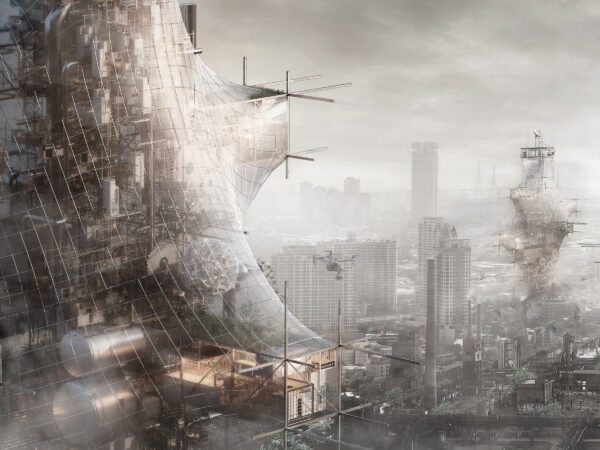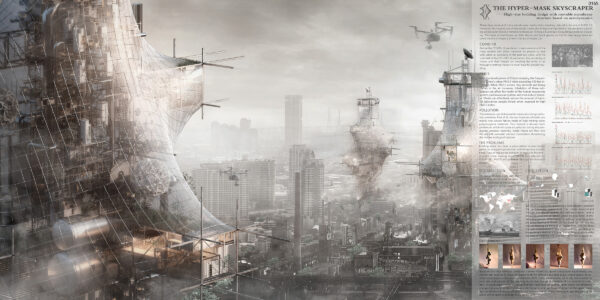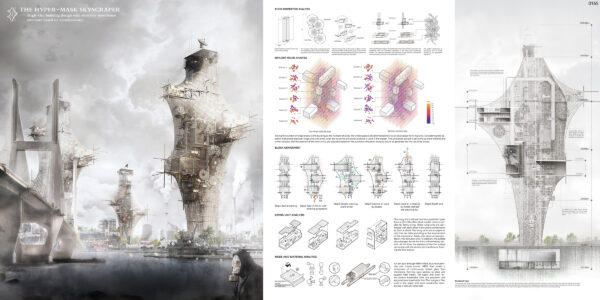Honorable Mention
2022 Skyscraper Competition
Yu Liu, Junjie Hou, Jiaxi Shi, Hailin Wu, Ronghui Yang, Jiang An
China
Before the COVID-19 pandemic, masks were one of the most reliable and direct methods for people to deal with urban air pollution; in the past two years, with the outbreak of the COVID-19 pandemic, the portability of masks and their impact on blocking the entry of air through breathing makes it a must-have for people traveling.
With the development of China’s industry, the frequency of China’s urban PM2.5 index exceeding 400 has increased. Masks can effectively reduce the number of harmful substances people inhale when exposed to a high PM2.5 index.
The extensive use of disposable masks also brings pollution problems. First of all, the raw materials of masks are mainly non-woven fabrics made of high melting index polypropylene materials. This material is derived from petroleum, which will cause air pollution during the production process; secondly, waste masks will flow into the sea with rainwater without incineration, threatening the marine ecological balance.
Building space has been a place where human beings gather to engage in production and living since ancient times. How to reduce the pollution of masks to the environment while making more people less affected by COVID-19、PM2.5 and pollution through architectural design?
From this, we think that adding a membrane to the whole building can filter air is like putting a mask on a human being, so as to achieve the purpose of isolating and filtering indoor and outdoor air. At the same time, in order to improve the interior air circulation, we make the building blocks move in the horizontal direction that can pull the membrane structure to shrink and relax, changing the air pressure in the membrane. When the air pressure in the membrane is lower than the external air pressure, the urban air which is filtered and purified by the membrane and the bottom device enters the building; when the air pressure in the membrane is greater than the external air pressure, the exhaust air filled with CO2 and other substances inside the building passes through the building. The exhaust air was purified, filtered, and discharged into the urban environment passed by the plant spaces and the roof garden.
Based on this idea, we have carried out a series of building space combination experiments and carried out membrane covering experiments for different building space combinations, to explore more space combination possibilities. After many experiments, we finally determined the track size and position of the building blocks that change the volume of the membrane structure. Through experiments, we found that the movement of multiple large blocks can effectively change the volume of the membrane. At the same time, we found that part of the space inside the membrane will not be affected by the volume change of the membrane, and this part of the space will be used to arrange living space units.
This skyscraper design first decided to use the steel truss for the overall structural system. The design centralizes all urban public activity spaces to form multiple large space blocks. The design distributes the large space blocks evenly throughout the whole space and reasonably sets the movement trajectory so that they can maximize the volume change of the membrane. The design determines the shape of membrane changes by simulating the movement of large public blocks. The design distributes a large number of residential blocks in the space that is less affected by the volume change of the membrane. The design uses a generative algorithm to attach the structures required for the living space units to the truss structure. At the same time, the design distributes the green space units between the large public space units and the living space units, and the design hopes to connect all the space units. These green spaces not only connect various spaces but also purify and filter the air entering the membrane. The design places a large green space at the top of the building. This large green space can re-purify the air in the membrane, so that clean air can enter the urban space from the membrane space.
















